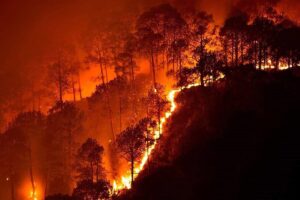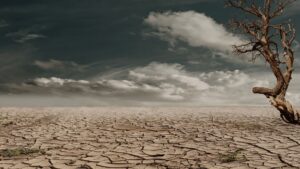In Addis Ababa, Ethiopia, a young girl waits in a long line for water, clutching an empty container. The queue stretches down the dusty road as families gather under the scorching sun hoping to fill their buckets before supplies run out. This scene has become increasingly common in cities and rural areas around the world, where climate change is disrupting water systems and leaving millions without access to safe drinking water.
From East Africa to North America, extreme weather events wildfires, floods, droughts, and heatwaves are pushing water infrastructure to its limits. Rivers are drying up, reservoirs are shrinking, and contamination is on the rise. Scientists and policymakers warn that without immediate action, the situation will only get worse, putting lives at risk and deepening global inequalities.

Wildfires Poison Water Systems
The consequences of climate-driven disasters are perhaps most evident in Paradise California. On November 8, 2018 the deadliest wildfire in state history engulfed the town, fueled by strong winds and dry conditions. The fire killed 85 people and destroyed 18,000 structures, leaving behind more than $16 billion in damages. But beyond the visible destruction silent crisis unfolded underground: the town’s water system was poisoned by the toxins released in the fire.
Kevin Phillips district manager of the Paradise Irrigation District “When a house burns the water lines connected to it are left open to the atmosphere, as water is sucked out, it depressurizes the system and pulls in smoke and contaminants.”
Tests conducted a year after the fire revealed benzene levels 80 times higher than the legal limit in some water samples. Benzene, a known carcinogen, seeped into plastic water pipes and storage tanks, rendering the entire system unsafe. It took seven years, multiple rounds of flushing, and $40 million in investments to fully restore safe drinking water in Paradise
While fires destroy pipes and pollute water with smoke and debris, floods bring their own set of challenges. In Asheville, North Carolina a thousand-year storm hit in September 2024, dropping 14 inches of rain in just three days. The deluge wiped out homes, businesses, and critical infrastructure including the city’s main water system.
Massive pipelines some buried 25 feet underground were washed away. Emergency crews scrambled to repair the damage, but thousands of residents were left without clean water for weeks. “We thought we were building the best system possible after the last flood,” said Asheville Mayor Esther Manheimer. “But when you’re dealing with an event this extreme, it’s almost impossible to prepare for.”
Flooding also leads to dangerous contamination. In Pakistan, Niger, and Chad, recent heavy rains overwhelmed sewage systems, causing human waste to mix with drinking water. The result: widespread outbreaks of diarrhea and cholera, particularly in communities already struggling with poor sanitation. In Chad, where food insecurity is already high, floodwaters also destroyed crops and stored food, exacerbating hunger and malnutrition.
Droughts Bring Hidden Dangers
At the other end of the spectrum, prolonged droughts are straining water supplies across the world. In Mozambique’s Nampula Province, disappearing rivers and dried-up wells have led to a rise in diseases like cholera, scabies, and schistosomiasis. Without reliable access to clean water, people are forced to rely on unsafe sources, increasing their risk of infection.
Droughts also alter water chemistry in ways that make treatment more difficult. When water levels drop, organic materials such as decomposing leaves and vegetation become more concentrated in reservoirs. This forces water treatment plants to use more chlorine to disinfect the supply. However, chlorine reacts with organic material to form dangerous byproducts, including trihalomethanes and haloacetic acids both of which are linked to cancer.
Saltwater Intrusion Threatens Coastal Cities
Even in places where water is still available, rising sea levels are making it unsafe to drink. The Mississippi River, a major source of freshwater for millions, has been running low due to drought and excessive heat over the past two years. As freshwater flow decreases, saltwater from the Gulf of Mexico moves upstream, threatening drinking water supplies in New Orleans and other communities.
“The seawater is rising and moving further up the river,” said Mark Cognevich, a water expert in Plaquemines Parish, Louisiana. “Last year, we had to bring in truckloads of bottled water because the tap water wasn’t safe to drink.” Officials are now racing to build a new water treatment facility with reverse osmosis technology to remove the salt. But for many residents, the damage is already done corroded pipes and appliances serve as reminders of the creeping threat of saltwater intrusion.
Algal Blooms Contaminate Freshwater Sources
As temperatures rise and extreme weather intensifies, another growing danger is harmful algal blooms. In the summer of 2014, a massive bloom in Lake Erie turned the water supply toxic, forcing residents of Toledo, Ohio, to stop using tap water for days. The culprit: cyanotoxins, poisonous compounds produced by certain types of algae that thrive in warm, nutrient-rich water.
Lake Erie’s algal blooms have worsened over time, says Sean Corson, director of NOAA’s National Center for Coastal Ocean Science. “They’re starting earlier, lasting longer, and reaching higher peaks.” The main contributors fertilizer runoff, heavy rainfall, and rising temperaturesare all linked to climate change, making future outbreaks even more likely.
Can We Adapt in Time?
Around the world, communities are struggling to keep up with the increasing threats to their water supplies. In Paradise, California, officials have redesigned the town’s water system with fire resistance in mind, replacing plastic pipes with brass meters and installing backflow preventers to stop contamination.
